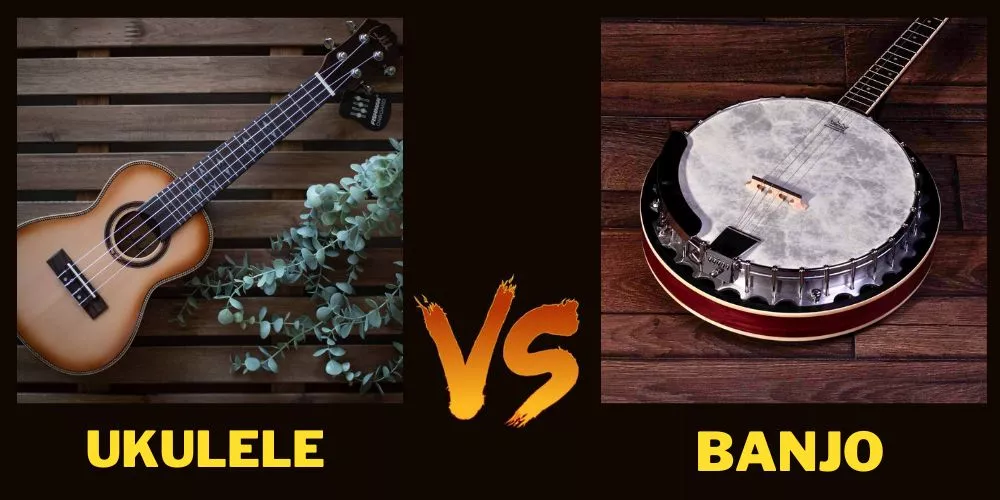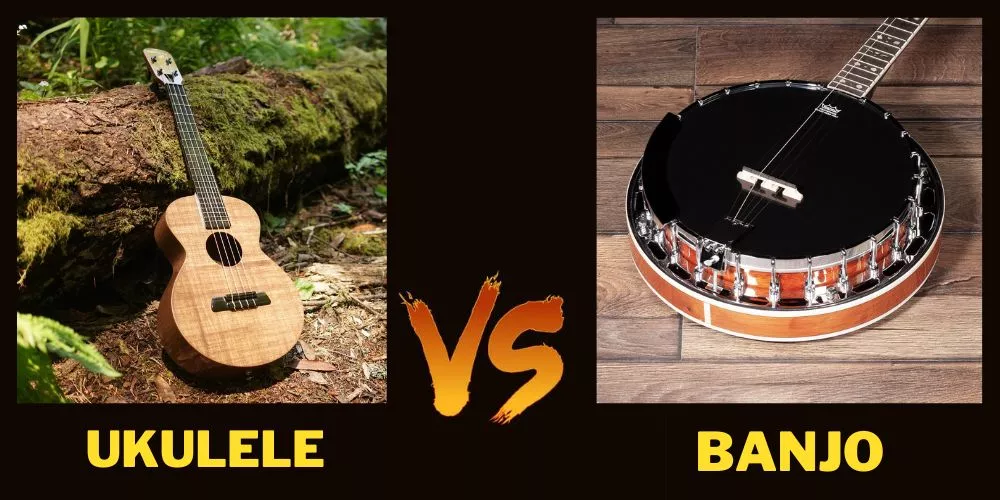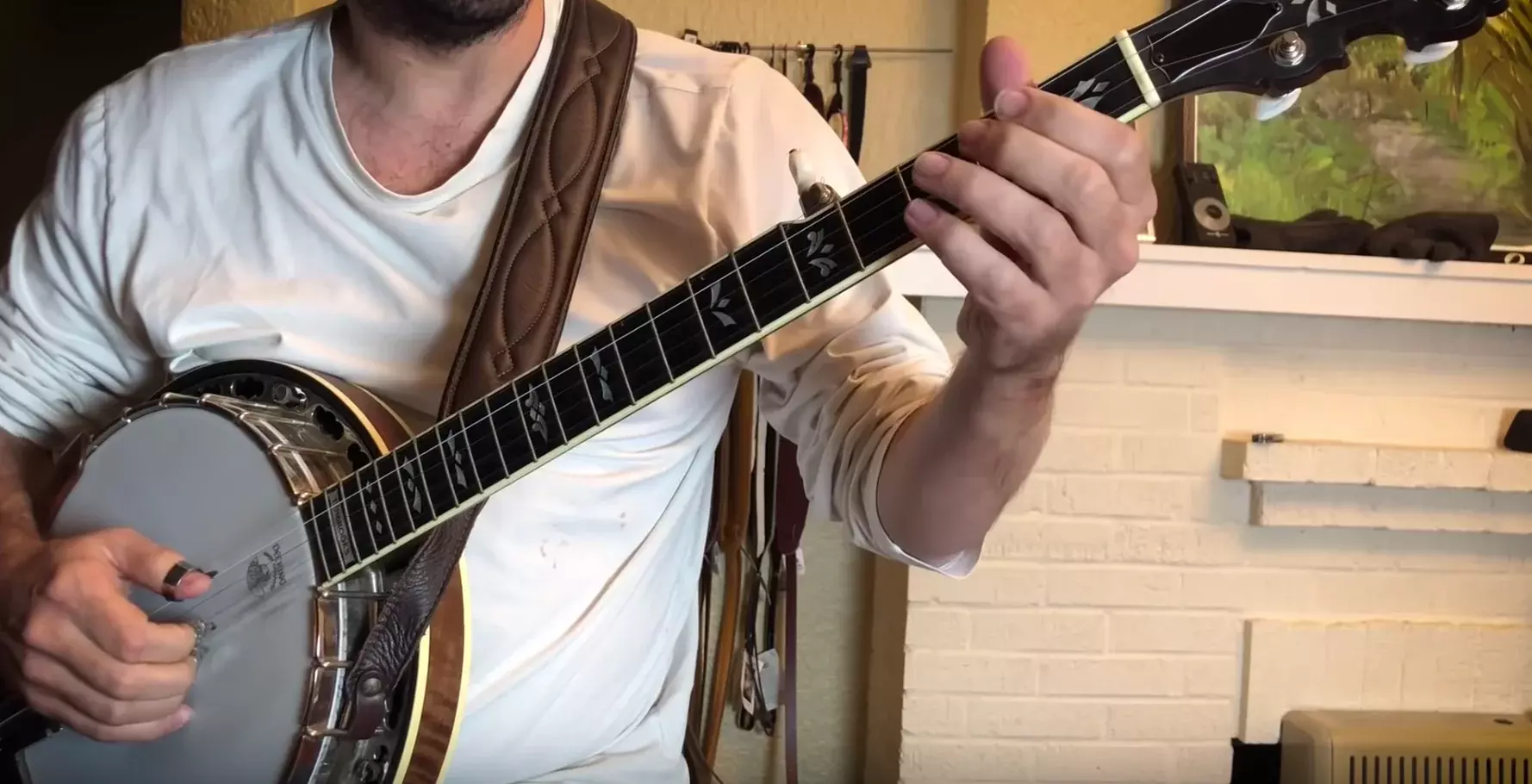The ukulele and banjo are distinct stringed instruments, each offering characteristics, playing styles, and tones. That’s why the debate of Ukulele vs Banjo is evergreen, and not easy to pick a one for sure.
Their key differences can be chalked up to construction, sound, playing techniques, and learning difficulty.
Ukuleles are small, with four nylon strings and a wooden body, often tuned to G-C-E-A. Their simplicity, ease of learning, portability, and light, melodic sound make them popular among beginners and laid-back musicians.
On the other hand, banjos, with their drum-like bodies and metal strings, exhibit a richer, resonating sound and are commonly associated with specific genres like country, folk, or bluegrass.

Available in different types like 4-string, 5-string, and 6-string, banjos generally require more complex playing techniques, such as finger rolls, making them a bit more challenging to learn.
While both instruments have a unique appeal, your choice between them should be influenced by personal preferences, musical goals, and the willingness to invest time in learning and practice.
Contents
🎶Ukulele vs Banjo
The Ukulele originated in Portugal and was adapted and popularized in Hawaii in the 19th century. Its name loosely translates to “jumping flea” in Hawaiian. Renowned ukulele players include Israel Kamakawiwo’ole, Jake Shimabukuro, and Grace VanderWaal.
The Banjo traced back to Africa, the banjo was brought to America during the era of enslavement. Early versions were crafted with gourd bodies and animal hide. Famous players include Earl Scruggs, Béla Fleck, and Pete Seeger.

Physical Characteristics
- Ukulele: The ukulele is light and compact with four nylon strings. It comes in four types, each differing in size: soprano, concert, tenor, and baritone. The construction materials involve various kinds of wood, typically mahogany or Koa.
- Banjo: Banjos are larger and heavier than ukuleles, usually having 4, 5, or 6 steel strings. They tout a distinctive circular drum body. Common construction materials include maple, mahogany, or walnut for the body, with plastic or animal hide for the drum head.
Sound Characteristics
Ukuleles produce a warm, soft tone owing to their nylon strings and wooden body construction. They possess a distinct melodic charm that’s soothing and whimsical. The sounds they produce can be divided into four subcategories depending on the size of the ukulele:
- Soprano: Known for its traditional, “classic” ukulele sound – bright, light, and playful.
- Concert: Offers a bit more resonance and richness thanks to its larger size but still retains the classic ukulele sound.
- Tenor: Provides a deeper, fuller sound with more volume and bass, owing to its larger body and scale length.
- Baritone: Sounds quite similar to a classical guitar with deep, rich tones, setting it apart from the typical ukulele sound.
The diverse sound range makes it perfect for strumming chords or fingerpicking, accommodating various musical styles, especially Hawaiian, pop, folk, and jazz.
Banjos, conversely, deliver a brighter, metal-string twang, offering sharp, punchy tones due to their circular drum-like body. They can be subdivided into:
- 4-string (Tenor/Plectrum): Known for a bright, staccato rhythm used traditionally in Dixieland jazz and Irish folk music.
- 5-string: Provides a resonant and plucky tone used widely in bluegrass and folk music.
- 6-string (Banjitar): Combines the banjo’s twang with a guitar’s tonal characteristics, suitable for a wide range of musical genres.
Banjos can exhibit an array of complex tonal characteristics depending on their construction and type, making them an excellent choice for intricate fingerpicking styles and strumming.
They are iconic in country music, bluegrass, folk, and Dixieland jazz music.
Learning Curve
Ukuleles are often recommended for novices in stringed instruments due to their relatively straightforward nature. Beginners should find the following aspects easy to tackle:
- String Comfortability: The four nylon strings of a ukulele are much softer and easier to press down than metal strings, providing a comfortable experience for the fingers, especially for youths or those with sensitive skin.
- Straightforward Chords: Many common ukulele chords involve only one or two fingers, enabling new learners to play songs quickly. Moreover, the chord patterns are symmetrical, which means learning a chord shape in one position allows the same shape to be used higher up the neck, transposing the chord.
- The abundance of Resources: From online platforms like YouTube and Udemy to books and local community classes, a plethora of resources are available for learning the ukulele at various levels.
While getting started is relatively simple, mastering the ukulele is a different story. Doing so requires consistent practice and developing techniques such as complex strumming patterns, fingerpicking, slides, bends, and chording nuances.
Banjos, especially 5-string types, are known for their somewhat steeper learning curve:
- String Tension: Banjos have metal strings that can be tougher on the fingers than nylon ones, and they need to be pressed with more force, which might be challenging for beginners.
- Picking Techniques: Banjos demand a more complex picking style, often involving the user’s thumb, index, and middle fingers – a particular technique known as “rolls.” These ‘rolls’ are patterns that circulate through the strings in various sequences, creating the characteristic banjo sound. This adds to the complexity of learning.
- Greater Number of Strings: Banjos often have more strings than ukuleles, requiring more precise finger placement and coordination.
However, proficiency in playing the banjo is certainly attainable with ample commitment and regular practice. Various online resources offer step-by-step lessons that aid in a clear understanding of the techniques involved.
The intricacy of mastering the banjo can make the learning journey more rewarding and offer a broader scope for musical creativity.
Pros and Cons
Ukulele
The ukulele boasts several advantages, including:
- Easiness to Learn: The ukulele’s simplicity, coupled with its soft nylon strings, allows beginners to pick up basic techniques very quickly.
- Cost-Effective: Generally, ukuleles are reasonably priced, making them an excellent choice for anyone on a budget or looking to try a stringed instrument without making a huge investment.
- Portability: Owing to its small size and lightweight, a ukulele is a popular companion for travelers or anyone who likes to play music on the go.
- Versatility: Even with its seemingly simple string setup, the ukulele allows for alteration of sound and tone via strumming or plucking techniques.
- Community: A large and friendly ukulele community worldwide is ready to share tips, lessons, and jam sessions.
However, like any instrument, the ukulele has its limitations:
- Limited Sound Range: Because ukuleles typically come with only four strings, they provide a more limited range of notes than stringed instruments.
- Volume: Ukuleles, especially smaller models, can lack the resonation and volume that larger stringed instruments possess.
- Perception: Due to its size and unique sound, the ukulele can sometimes not be taken as seriously as other instruments.
Banjo
The banjo, with its distinctive sound and cultural history, offers several advantages:
- Unique Sound: The banjo’s rich, resonating sound and wide tonal range distinguishes it from most stringed instruments. It manages to bring a distinct personality and depth to any musical composition.
- Versatility: Different banjos (4-string, 5-string, 6-string) cater to diverse music styles, from jazz to country to folk.
- Community: Banjo players, too, share a deep, interconnected community worldwide, with plentiful festivals, conventions, and jam sessions.
However, prospective banjo players should be aware of a few considerations:
- Price: Banjos are usually pricier than ukuleles. While there are budget-friendly options, quality banjos that produce a superior sound often come at a higher cost.
- Learning Curve: The banjo’s complex finger/thumb picking techniques and multiple strings can prove challenging, especially for beginners.
- Size and Weight: Banjos, larger and heavier than ukuleles, aren’t as portable and can be slightly unwieldy to some players.
- Maintenance: Because of its design, including its drum-like body and metallic components, a banjo typically requires higher maintenance than a ukulele.
Famous Musicians and Songs
Notable ukulele musicians like Tiny Tim, George Harrison, and Zooey Deschanel helped popularize the instrument. Iconic songs include “Over the Rainbow” by Israel Kamakawiwo’ole and “Riptide” by Vance Joy.
Famous banjo players like Steve Martin and Mumford & Sons broadened the banjo’s reach. Significant songs include “Foggy Mountain Breakdown” by Earl Scruggs and “Wagon Wheel” by Old Crow Medicine Show.
The choice between a ukulele and a banjo comes down to personal preference. Reflect on the sound, price, playability, and level of commitment.
Remember, every journey begins with a simple step, and soon, with practice, you’ll create beautiful music of your own.
🎶Is it easier to learn banjo or ukulele?
When it comes to learning a stringed instrument, it’s largely subjective and dependent on an individual’s musical inclination, prior experience, and personal commitment to practicing.
However, in consensus, the ukulele is easier to learn than the banjo.

Ukulele: The small size, soft nylon strings, and simple chord structures of the ukulele make it a beginner-friendly instrument. The ukulele has only four strings, allowing for simpler chords and strumming patterns.
Plenty of songs can be played with just a few chords, motivating beginners looking to play tunes quickly.
Banjo: On the other hand, learning the banjo is usually more challenging due to its playing style. Most types of banjos (like the popular 5-string) involve a unique picking technique requiring the use of the thumb and multiple fingers.
This technique, called ‘rolls,’ can seem complex to new players. Additionally, banjos generally have metal strings which are a bit harder on the fingers than a ukulele’s nylon strings.
However, both instruments require continuous practice to master their respective techniques. Thus, an individual’s progress on either instrument will parallel their dedication to practice and learning.
🎶Can you play the banjo like a ukulele?
While the banjo and the ukulele are stringed instruments, they differ significantly in sound, playing technique, and string arrangement. Therefore, you typically can’t play the banjo exactly like a ukulele.

However, a hybrid instrument exists called the ‘banjolele’ or ‘banjo ukulele.’ Combining the small scale, tuning, and playing style of a ukulele with the construction and distinctive tone of a banjo, the banjolele allows for ukulele-like playability with the bright, projecting sound.
There is also a type of banjo called the ‘banjo uke,’ which is tuned like a ukulele and played with ukulele-style chord shapes, but it replicates the tone and timbre of a banjo.
🎶Are banjo and ukulele chords the same?
Technically, a chord is a harmonic set of three or more notes that is heard as if sounding simultaneously.
Therefore, chords, by their nature, remain the same across instruments. However, the shapes, fingering formations, and tablatures to play these chords vary substantially between the banjo and the ukulele due to their differing string numbers, tuning, and string arrangement.

Ukulele Chords
Ukuleles typically have four strings. The most common ukulele tuning is G-C-E-A (from top to bottom when holding the ukulele). This results in chord shapes vastly different from those on a banjo.
For instance, a C major chord on a ukulele is very simple, requiring you to place your ring finger on the third fret of the bottom A string while the rest of the strings are played open.
Banjo Chords
Standard 5-string banjos have a unique tuning: G-D-G-B-D (from top to bottom when holding the banjo).
The additional fifth string (the first G) is a high drone string shorter than the others and typically played open in most chords. For instance, a C major chord on a banjo involves:
- Pressing the first string at the second fret.
- Leaving the second string open.
- Pressing the third string at the first fret.
- Leaving the fourth string open.
- Pressing the fifth string at the second fret.
So, while the musical theory behind the chords stays the same, how they’re formed and played on each instrument is different. Switching from one instrument to the other would require learning new chord shapes and finger positioning.
Sure! Here’s an additional 300 words you can add to the article, expanding on how each instrument is used in various genres, along with tips for choosing between the two.
Musical Genres and the Role of Ukulele and Banjo
Ukulele in Modern Music
While the ukulele has roots in Hawaiian music, it has found a place in numerous other genres. Its light, cheerful sound has been adopted by musicians in pop, rock, folk, and indie music. The ukulele’s presence in popular songs like “Riptide” by Vance Joy or “I’m Yours” by Jason Mraz has helped elevate its appeal beyond traditional Hawaiian music.
Its ability to strum basic chords and produce catchy, uplifting melodies makes it a favorite for singer-songwriters and performers looking for a more intimate sound.
Furthermore, the ukulele’s use in jazz and folk music has brought it into the spotlight with artists like Jake Shimabukuro, who blends virtuosity with the instrument’s traditional charm. The ukulele is also commonly featured in film soundtracks, such as in the movie 50 First Dates, where its playful and whimsical tone adds to the atmosphere.
Banjo’s Role in Bluegrass and Folk Music
The banjo is iconic in bluegrass and folk music, where its bright, resonant sound carries a sense of energy and tradition. Bluegrass music, in particular, features the banjo prominently, with the five-string model providing the characteristic rolls and fast-paced picking.
Master banjo players, like Earl Scruggs, developed complex techniques that are still revered today in the genre. The banjo’s bright tone helps cut through the dense layers of other instruments, providing a rhythm and melodic backbone to the music.
Besides bluegrass, the banjo is also found in country, Appalachian, and even Dixieland jazz, where it adds a punchy rhythm or a melodic flair. The versatility of the instrument has allowed it to transcend its roots and become an integral part of various folk music traditions worldwide.
Making Your Choice
When deciding between a ukulele and a banjo, consider the type of music you want to play. If you are drawn to light, catchy tunes, or are looking for something easy to learn and portable, the ukulele might be the right choice.
On the other hand, if you love the intricate, rhythmic patterns of folk, bluegrass, or country, the banjo will provide a rewarding challenge. Regardless of which instrument you choose, both the ukulele and the banjo offer unique ways to express yourself musically.
Conclusion:
Both ukulele and banjo offer unique advantages and experiences. The ukulele, known for its simplicity, affordability, and portability, is ideal for beginners or those seeking a light, melodic sound.
The banjo, although requiring more dedication to master, provides wider tone variety and depth, making it beloved in specific music genres.
Ultimately, the choice falls upon the individual’s musical preference, time commitment, and stylistic interests.
Both instruments harbor the ability to enrich one’s musical journey, encouraging therapeutic self-expression and sparking creativity. Whichever you choose, happy strumming!
